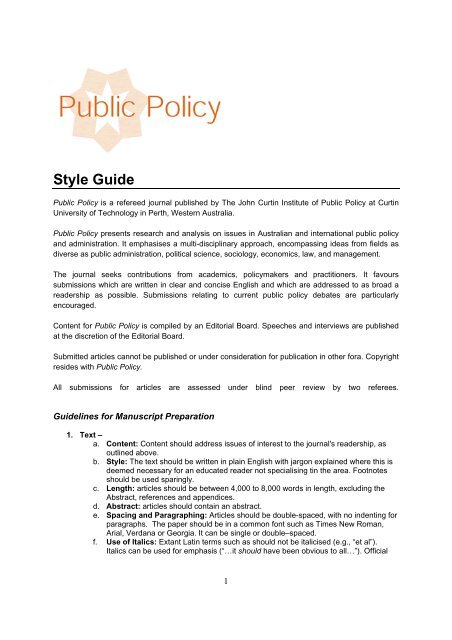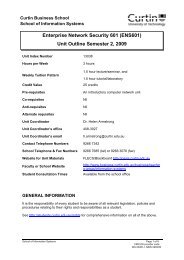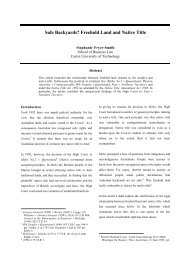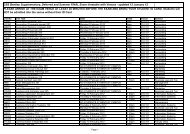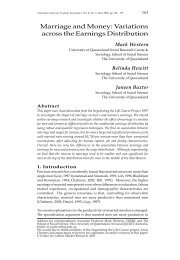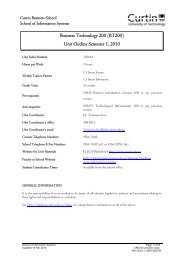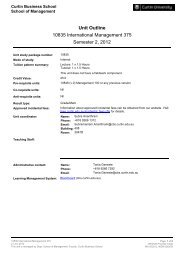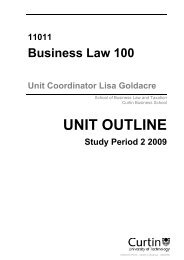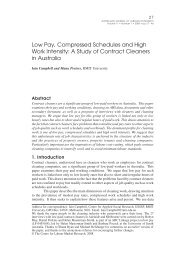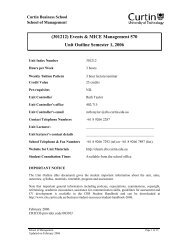Public Policy Style Guide - Curtin Business School - Curtin University
Public Policy Style Guide - Curtin Business School - Curtin University
Public Policy Style Guide - Curtin Business School - Curtin University
Create successful ePaper yourself
Turn your PDF publications into a flip-book with our unique Google optimized e-Paper software.
<strong>Style</strong> <strong>Guide</strong><br />
<strong>Public</strong> <strong>Policy</strong> is a refereed journal published by The John <strong>Curtin</strong> Institute of <strong>Public</strong> <strong>Policy</strong> at <strong>Curtin</strong><br />
<strong>University</strong> of Technology in Perth, Western Australia.<br />
<strong>Public</strong> <strong>Policy</strong> presents research and analysis on issues in Australian and international public policy<br />
and administration. It emphasises a multi-disciplinary approach, encompassing ideas from fields as<br />
diverse as public administration, political science, sociology, economics, law, and management.<br />
The journal seeks contributions from academics, policymakers and practitioners. It favours<br />
submissions which are written in clear and concise English and which are addressed to as broad a<br />
readership as possible. Submissions relating to current public policy debates are particularly<br />
encouraged.<br />
Content for <strong>Public</strong> <strong>Policy</strong> is compiled by an Editorial Board. Speeches and interviews are published<br />
at the discretion of the Editorial Board.<br />
Submitted articles cannot be published or under consideration for publication in other fora. Copyright<br />
resides with <strong>Public</strong> <strong>Policy</strong>.<br />
All submissions for articles are assessed under blind peer review by two referees.<br />
<strong>Guide</strong>lines for Manuscript Preparation<br />
1. Text –<br />
a. Content: Content should address issues of interest to the journal's readership, as<br />
outlined above.<br />
b. <strong>Style</strong>: The text should be written in plain English with jargon explained where this is<br />
deemed necessary for an educated reader not specialising tin the area. Footnotes<br />
should be used sparingly.<br />
c. Length: articles should be between 4,000 to 8,000 words in length, excluding the<br />
Abstract, references and appendices.<br />
d. Abstract: articles should contain an abstract.<br />
e. Spacing and Paragraphing: Articles should be double-spaced, with no indenting for<br />
paragraphs. The paper should be in a common font such as Times New Roman,<br />
Arial, Verdana or Georgia. It can be single or double–spaced.<br />
f. Use of Italics: Extant Latin terms such as should not be italicised (e.g., “et al”).<br />
Italics can be used for emphasis (“…it should have been obvious to all…”). Official<br />
1
documents and reports (e.g., Bringing them Back Home) should be, as should full<br />
and abbreviated titles for legislation (e.g., WorkChoices; Constitution Alteration<br />
(Social Services) Act 1946).<br />
g. Use of the Hyphens, “En dash” and “Em dash”: Hyphens should be used to<br />
separated commonly compounded words (e.g., fig-leaf); En dashs to highlight<br />
numerical ranges (4–6) and relationships or connections (e.g., London–New York);<br />
Em dashs to highlight a parenthetical thought (e.g., “others might have said<br />
something — and many did — but he remained silent.”).<br />
h. Copyright: It is the author’s responsibility to ensure that any submitted and<br />
published article conforms to standard professional practices regarding the sourcing<br />
of already published work – i.e., all quoted material should be identified in the text,<br />
cited and referenced appropriately.<br />
i. Submission format: all articles should be submitted in electronic format, preferably<br />
in a recent version of MS Word.<br />
2. Use of Headings –<br />
a. Paper title should be capitalised, with text after a colon uncapitalised, e.g., “Following<br />
the Money Trail: government spending, the missing millions and the unknown<br />
effects.”<br />
b. Running Header: The running header should be a brief title summarising the paper in<br />
six words or less, e.g., “Social Marketing of Water Conservation”.<br />
c. The introductory section should not have a heading.<br />
d. There are two primary levels of headings: Heading 1 for sections (e.g., How was<br />
Whole-of-Government Implemented?) and Heading 2 for sub-sections (e.g.,<br />
Bilateral Agreement Making).<br />
e. A third level – (i) Heading 3 (e.g., (i) Recent Bilateral Agreements) is acceptable for<br />
listings of extended points within a sub-heading.<br />
f. The reference section is called References<br />
3. Use of Figures and Tables –<br />
a. Figures (diagrams and schemata) and tables (reporting text and numbers) should be<br />
legible and located in the text.<br />
b. All figures and tables should be numbered separately, e.g., Figure 1 (1,2,3…) and Table 3<br />
(1,2,3…) and in a consistent manner throughout the paper.<br />
c. External copies of figures and tables should be made available to the editors upon<br />
request.<br />
4. Use of Quotations –<br />
a. Normal Use, e.g., in reference to a phrase and where emphasis is required: ‘healthy<br />
finances’;<br />
b. Lengthy Quotation, e.g., “Are multiple councils deemed to be ‘at risk’ or have they<br />
merely been erroneously classified as ‘at risk’?”<br />
c. Block Quotation, Paragraph quotes should be typeset using indentation, e.g.,:<br />
A council’s long-term financial performance and position is sustainable<br />
where: (i) continuation of the council’s present spending and funding policies;<br />
(ii) likely developments in the council’s revenue-raising capacity and the<br />
demand for and cost of its services and infrastructure; and (iii) normal<br />
financial risks and financial shocks, altogether are unlikely to necessitate<br />
substantial increases in council rates (or alternatively, disruptive services<br />
cuts).<br />
5. Citation and Referencing –<br />
a. Citation in Text: References should use the author date system, e.g.,: Johnson<br />
(2006); Astor and Chinkin (1992: 12–20); (Johnson 2006:11); (Johnson 2006; Astor<br />
2
and Chinkin 1992: 12–20). The journal encourages the limited use of footnotes for<br />
references, almost exclusively for legal referencing, as per (i) below.<br />
b. Reference: as below.<br />
i. Author listings only require the first (and second/third, if necessary) initial, rather<br />
than the first name (e.g., Musgrave, W).<br />
ii. Multiple references in the same year from an author(s) should be distinguished<br />
using lettering, e.g., Craven 2006a; Craven 2006b…<br />
iii. Organisations with Acronym names should be referenced by acronym (e.g.,<br />
ATSIS – Aboriginal and Torres Strait Islander Social Justice Commissioner).<br />
iv. Unpublished or Forthcoming works should be cited as in the case below, with<br />
exact publication details given as (unpublished) or (forthcoming) in place of<br />
volume/issue bibliographic details.<br />
c. Books:<br />
Astor, H and C Chinkin (1992) Dispute Resolution in Australia. Sydney:<br />
Butterworths.<br />
d. Book Chapters:<br />
Musgrave, W (2007) ‘Historical Development of Water Resources in Australia: The<br />
Case of Irrigation <strong>Policy</strong> in the Murray-Darling Basin’, in L Crase, ed, Water <strong>Policy</strong><br />
in Australia Washington DC: Resources for the Future.<br />
e. Journal Articles:<br />
Blau, F and L Kahn (1992) ‘The gender earnings gap: learning from international<br />
comparisons’, American Economic Review 82:3.<br />
(n.b. we don’t require the inclusion of page numbers for references.<br />
f. Conference Paper/Working Paper:<br />
Freebairn, J (2005) ‘Early Days with Water Markets’, Industry Economics<br />
Conference, Melbourne: La Trobe <strong>University</strong>, September 11-15.<br />
g. Conference Presentations:<br />
Gregory, R and A Daly (1992) ‘Who gets what? Institutions, human capital and<br />
black boxes as determinants of relative wages in Australia and the US’, Paper<br />
presented at the 9th World International Industrial Relations Association Congress,<br />
Sydney, August 12 – 14.<br />
h. Government Reports: ATSIS – Aboriginal and Torres Strait Islander Social Justice<br />
Commissioner (2003) Social Justice Report 2003. Sydney: Human Rights and<br />
Equal Opportunity Commission.<br />
i. Downloads: Plowman, D H (2002) ‘The Origins of Compulsory Arbitration in<br />
Western Australia’, Presentation to the Industrial Relations Society of Western<br />
Australia, available at:<br />
http://www.industrialrelations.com.au/listStory/Papers%20and%20Presentations/20<br />
02<br />
j. Legal Referencing: Footnote referencing allowed for legislation and court cases:<br />
i. Legislation: Can be referenced in full in the text: Constitution Alteration (Social<br />
Services) Act 1946.<br />
ii. Court Cases: Cases can be cited in text via footnotes, e.g.,: “A less obvious,<br />
but relevant Commonwealth power, is the so-called implied power from<br />
nationhood. 1 ”<br />
Further Information<br />
For further details about the journal, its submission standards and online access to previous issues,<br />
please go to the main site at: http://jcipp.curtin.edu.au/publications/publicpolicy.html<br />
1 As expressed by the High Court in such cases as: Victoria v. Commonwealth and Hayden (1975) 134 CLR 338;<br />
and Davis v. Commonwealth (1988) 166 CLR 79.<br />
3


